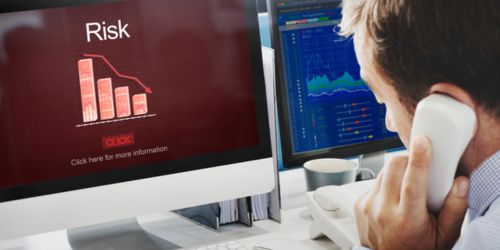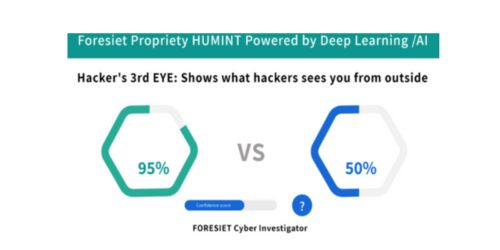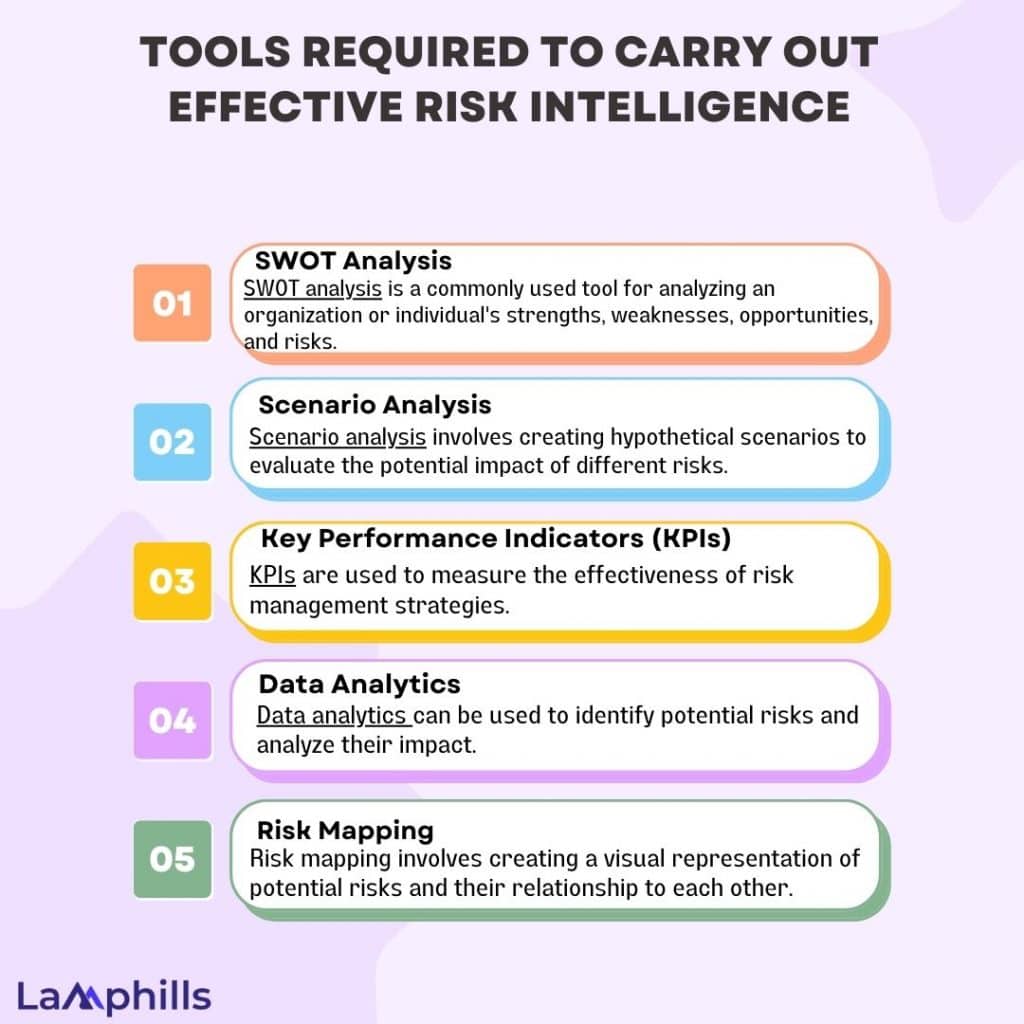Risk intelligence involves the gathering of information to identify potential risks. This information assists organizations in identifying risks that could undermine their achievements and everyday decision-making. The risk intelligence procedure entails uncovering such risks, evaluating their probability, and taking preemptive measures to mitigate their potential impact. But why is this important?
Read on as I explain risk intelligence, why it is important, and the best risk intelligence software your company needs to effectively fight against cyber-attacks.
Key Points
- Risk Intelligence is the most potent way for risk teams to identify fraudulent/legitimate and risky/creditworthy customers.
- Elements of risk intelligence include risk awareness, risk analysis, risk evaluation, risk mitigation, and risk observation.
- Risk intelligence is critical for individuals and organizations to navigate their complex and uncertain world. Strong risk intelligence can assist people and organizations in predicting and managing possible risks more effectively, increasing success and resilience in adversity.
- Risk Intelligence software is designed to gather data and analyze trends, then provide your organization with actionable intelligence regarding cybersecurity threats.
- When selecting risk intelligence software, you may look for key features such as prioritized alerts, accurate and precise analysis, and actionable insights that suggest the best means of remediation.
- Conducting risk intelligence takes a combination of skills, experience, and the right tools and methods. These tools include SWOT analysis, scenario analysis, key performance indicators (KPIs), data analytics, and risk mapping.
What is Risk Intelligence?
Risk intelligence refers to the tool organizations use regularly to recognize, prevent, or control the duration and impact of stakeholder risk situations. It is carried out continuously and in a verifiable manner. Organizations may use risk intelligence to obtain the necessary information to recognize, measure, and control their risks.
By integrating risk intelligence, businesses across all sectors of the economy can identify possible threats, such as supply chain disruption, cyberattacks, financial risks, extreme weather, or disgruntled customers.
Managing risks across various segments calls for the need for risk intelligence apps. How is it possible to mitigate something that is not monitored?
The risk landscape of the supply chain serves as an example. According to a recent Gartner report, only 20% of global executives claim to supervise their most essential subcontractors successfully. Businesses are suffering from the overall lack of visibility in this sector, which causes them to suffer unanticipated consequences when problems arise beyond the top tier of the supply chain.
Similar to this, different industries have various security and service threats. At this point, risk managers need to be aware of the possible dangers to their sector and have plans to reduce them. A risk intelligence solution like Exiger’s Supply Chain Explorer is powered by machine learning and AI. It can help businesses make better decisions in real-time by quantifying and prioritizing the risks that must be managed.
Key Elements of Risk Intelligence
Understanding a few fundamental components of risk intelligence is crucial. Among them are:
- Risk awareness: This relates to the capacity of a person or group to detect and identify potential risks. A thorough grasp of the environment, including the social, political, and economic elements that may affect risk, is necessary.
- Risk analysis: Once a risk has been identified, it must be analyzed to determine its likelihood and potential impact. This requires gathering and interpreting data and using analytical tools and techniques to evaluate the risk.
- Risk evaluation: After analysis, assessing the risk’s possible effects on the person or organization is crucial. This requires a thorough awareness of all possible outcomes and the capacity to rank risks according to their possible significance.
- Risk mitigation: It’s essential to reduce or manage risks when they have been noticed, examined, and evaluated. This could entail putting risk management techniques like risk acceptance, transfer, avoidance, and reduction into practice.
- Risk observation: Lastly, keeping an eye on the risks and the efficiency of the risk management techniques is critical. This enables people and organizations to adapt to changing conditions and make changes as needed swiftly.
In addition, organizations can get information on the risks they face using various methods. These techniques include analyzing internal data, assessing websites, obtaining information from experts or stakeholders, and conducting outside research.
Using data from several sources in combination offers a comprehensive understanding of the possible obstacles that a firm can encounter. This is especially important because a single risk might compromise a company’s earnings and standing.
Methods to Identify Risk
Several methods can be used to identify risk. One common approach is using a risk management tool like a Risk Register. This allows you to identify and track risks systematically.
Another approach is to carry out a risk assessment. This involves looking at all the potential risks that could affect your organization and assessing their likelihood and impact. This can help you prioritize which risks need to be managed more carefully.
It’s also essential to keep updated with changes in your industry and sector, as this can create new risks that you must be aware of. Keeping abreast of developments in your field can help you identify emerging risks early on.
Finally, it’s also helpful to talk to other businesses in your sector about the risks they are facing. Sharing information about risks can help you build a better picture of the landscape and identify areas where you may be particularly vulnerable.
Why is Risk Intelligence Important?

Risk intelligence is a crucial part of operational risk management. Companies that use the risk identification and analysis process can improve their ability to identify and respond to risks. This is particularly important when a single risk could compromise a company’s success.
Companies use several methods to collect data on the risks they face. They might use an internal data analysis, website audit, external research, or insight from stakeholders or experts. Gathering insight from several sources provides a broad perspective on company challenges.
Every business should take steps to analyze the information they find. Assessing collected data — through methods like risk mapping and trend analysis — can provide new insights into each potential risk. These insights allow companies to consult data when developing a risk management strategy.
Traditional Risk Assessment vs Risk Intelligence: Comparison
Let’s see how modern risk intelligence programs vary from traditional risk assessments to appreciate their worth.
| Traditional risk assessment processes are… | Modern Risk Intelligence is… |
| Manual Risk teams are overwhelmed with document reviews and struggle to support a growing business without increasing risk. | Digital AI-enabled software produces clear and actionable insights that help risk teams make the best decision – fast. |
| Subjective Risk analysts take educated guesses to identify manipulated documents, leaving their business open to fraud and credit losses. | Objective Risk Intelligence is based on AI-enabled technology guided by clearly defined standards and metrics – not hunches, guesses, or intuition, which may also be clouded by human perception and bias. |
| Painful Customers must wait hours, days, or weeks to access financial products. | Efficient and effective Companies review documents and identify signs of fraud or manipulation in seconds –giving customers the answers they need and the experience they expect while freeing up staff to focus on higher-value tasks. |
Risk Intelligence Test Checklist
Lamphills Risk Intelligence Test Checklist
What Are the Benefits of Risk Intelligence?
Risk intelligence is a relatively new concept in business but quickly gaining traction. It is the ability to collect and analyze data to identify risks and opportunities. It can be used in various ways, but its ultimate goal is to help businesses make better decisions about managing risk. Here are some of the top benefits of risk intelligence.
#1. Profitability and Growth Are Fueled by Risk Intelligence
Risk intelligence is critical in helping businesses lower risk and boost profitability and growth. Process automation, which speeds up and lowers the cost of document reviews, is the primary method.
What’s more, the company may reduce employee tiredness, which could lead to insufficient or inaccurate choices, by eliminating laborious, time-consuming manual evaluations. Lastly, risk managers can focus on higher-value, customer-facing work that supports the company’s growth by automating repetitive and regular operations.
#2. It Improves Accuracy and Reduces Risk
Risk intelligence also prompts the organization to think more structured and comprehensively about risk. As part of this process, businesses must define risks and outline the standards by which to measure them, as well as mechanisms that will be used to identify them.
Risk assessment is no longer subjective, but objective – and therefore more consistent and effective. Instead of manually reviewing all documents for signs of fraud, analysts can now focus only on those cases that genuinely need their attention. Best of all, with the help of risk intelligence software, analysts typically have more confidence in their decisions and can more easily articulate the logic for questionable cases.
#3. Risk Intelligence Contributes to the Development of a More Just and Equal Financial System for All
Broadly speaking, risk intelligence can also contribute to developing a more just and equitable financial system by facilitating the access of millions of unbanked, “thin file,” and credit invisible consumers to the goods and services they require.
Banks, financial institutions, and other businesses can accept legitimate clients they might not otherwise be able to when they use risk intelligence tools to eradicate blatant fraud.
What Are The Steps Involved In Risk Intelligence?: Best Practices
Risk intelligence is critical for individuals and organizations to navigate our complex and uncertain world. Strong risk intelligence can assist people and organizations in predicting and managing possible risks more effectively, increasing success and resilience in adversity.
In the modern world, risk intelligence is a crucial component of success. Risks are always changing and taking on new forms due to rapid social, political, and technological improvements. However, anyone can build strong risk intelligence to traverse the complexity of the modern world with the correct tools, tactics, and mentality.
Here are some steps to consider when carrying out risk intelligence:
#1. Developing a Complete Understanding of the Risks
This requires being aware of your surroundings, keeping up with global developments, and having an acute sense of risk. It also entails determining which hazards are most likely to have a major influence and ranking them according to their likelihood of impacting a person or organization.
#2. Analyzing The Risk
Once risks have been identified, the next step is to analyze them to determine their likelihood and potential impact. This requires gathering and interpreting data, using analytical tools and techniques, and evaluating the risk from different angles. It is important to look beyond the surface level and understand the root causes and potential consequences of different risks.
#3. Assessing The Potential Impact of The Risk
After analyzing the risks, assessing their potential impact on an individual or organization is essential. This involves weighing the pros and cons of different risk management strategies, and deciding which approach best suits the particular situation. It is important to remember that not all risks are equal, and some may require more urgent action than others.
#4. Manage The Outcome From The Risk
Once the risks have been assessed, it is time to mitigate or manage them. This may involve implementing risk management strategies such as risk transfer, avoidance, reduction, or acceptance. For example, if the risk is related to cyber security, implementing more robust security measures may be necessary to reduce the risk of data breaches.
#5. Monitor the Risk and Use Sensible Management Techniques
Lastly, monitoring the risks and the efficiency of the implemented risk management techniques is critical. This requires ongoing observation and assessment and the capacity to adapt as needed. Individuals and organizations can stay ahead of risks and guarantee long-term success by being watchful and attentive.
Risk Intelligence Software
Risk Intelligence software is designed to gather data and analyze trends, then provide your organization with actionable intelligence regarding cybersecurity threats. This information must be collated efficiently, ensuring that risk insights can be delivered promptly. Once armed with this intelligence, organizations can better protect themselves from the threats they face.
Risk Intelligence software is designed with a specific use case in mind. Therefore, you must ensure you select the right software for your needs and uses. If your software is not the right fit and focuses on intelligence that is not directly relevant to your organization, you may not get the most coverage from your platform. The best risk intelligence software will have many features to ensure data is gathered and analyzed effectively. It can also be very helpful for prioritizing alerts, as this prevents the admin from responding to insignificant notifications. Instead, your human resources can focus on their other tasks, knowing they will be warned of significant risks.
Each software will use a different combination of AI, ML, human expertise, and automation to quantify the level and type of risk your organization faces. Some might specialize in brand protection, while others focus on risk-actor identification. Before selecting software, you must know the risks you face and what you want your software to detect. Finding the right software is the first step to delivering robust and effective risk intelligence.
When selecting risk intelligence software, you may look for key features such as prioritized alerts, accurate and precise analysis, and actionable insights that suggest the best means of remediation.
Best Risk Intelligence Software
Here are the top 5 best risk intelligence software.
#1. Resolver

Resolver, a Kroll Business, stands at the forefront of risk intelligence, safeguarding over $6.5 trillion in market cap for more than 1,000 global companies. Leveraging AI with deep human expertise, their innovative Risk Intelligence software provides comprehensive visibility into enterprise-wide risks, enabling prioritized, timely, and agile responses. Trusted for their comprehensive risk & audit, compliance, enterprise security & investigations, brand equity protection, and platform trust & safety solutions, they help you thrive in adversity and safeguard your operations, brand, and bottom line.
Go beyond tracking and managing risk to transforming complex data into clear insights and highly effective mitigating actions. By harnessing their integrated capabilities, businesses of all sizes can reduce crises, recover swiftly, and emerge stronger — protecting operations, brand equity, and bottom line.
Resolver gathers and analyzes all risk data in context, revealing the true business impact within every risk. Resolver’s Risk Intelligence Platform traces the extended effect of all types of risk—whether compliance or audit, incidents, or threats—and translates those effects into quantifiable business metrics. So customers can communicate risk persuasively and frame it in terms of the business. And with this changed perspective, comes an entirely new role for risk. Finally, risk goes from being seen as a barrier, to becoming a strategic partner driving the business. Welcome to the new world of Risk Intelligence.
#2. RiskLens

RiskLens helps companies better justify, prioritize, and manage the cybersecurity investment decisions and risks accompanying digital growth and transformation. By scaling their quantitative cyber risk management programs, enterprises can make more informed decisions, optimize their cybersecurity investments and outcomes, and address regulatory and privacy requirements.
Organizations achieve these outcomes because they can understand and communicate their cyber risks in the financial terms standard to enterprise risk management, facilitating improved decision-making across the C-Suite and Board.
The RiskLens software is the only enterprise-scale SaaS application based on Factor Analysis of Information Risk (FAIR™), recognized by the National Institute of Standards and Technology (NIST) as the standard for the quantification of cyber and technology risk, with a community of more than 10,000 FAIR practitioners worldwide.
#3. Memcyco

Infused with AI, Memcyco’s real-time digital risk intelligence software grants businesses full visibility and control of phishing-related digital impersonation fraud before ATO, money theft, data breaches, and ransomware occur. How? Its unique ‘nano defender’ technology detects, protects, and responds to attacks as they unfold.
Memcyco is the only end-to-end risk intelligence software that combats brand impersonation attacks that originate via spoofed websites. It safeguards your business and your customers during the critical ‘window of exposure’ (from when a fake site goes live until it’s taken down).
Finally, Security, Fraud, and Digital Business teams can see the full attack scope and customer identities, instantly disarming and locking out fraudsters while optimizing risk engine prediction.
Memcyco secures tens of millions of customer accounts daily, helping to save millions in incident remediation costs while reducing the impact on customers, workloads, expenses, and reputation.
Main Features:
- Detects fake websites in real-time.
- Agentless end-user protection protects the company and its customers from website impersonation attacks.
- Embeds an active ‘nano defender’ tracking sensor in your company’s authentic site to provide real-time maximum attack visibility and complete protection for the company and its customers.
- Displays a forge-proof authenticity watermark to confirm the legitimacy of your site.
- Responds with detailed forensics, enriching your risk engine with valuable data about the attack & attacker, which allows you to reduce the impact/MTTD/MTTR from 48 hours to 1 hour!
This is best for digital businesses, such as financial institutions, that are vulnerable to brandjacking, ATO attacks via SSO, and impersonation fraud.
#4. Foresiet

Foresiet leverages Artificial Intelligence to offer predictive insights into potential digital threats, aligning with the article’s narrative on the need for proactive measures in DRP. Its focus on anticipatory analytics allows organizations to stay ahead of threats, which is crucial for maintaining the security and integrity of e-commerce operations, which the article underscores as being particularly vulnerable to digital risks.
Main Features:
- Predictive Risk Analysis: Uses AI to proactively forecast digital risks and prevent them.
- Brand Monitoring: Continuously scans for brand-related risks across the digital landscape.
- Digital Resilience Planning: Assists organizations in building more robust digital defences against brand-related threats.
Best for businesses looking for AI-driven risk anticipation and proactive digital brand defence.
#5. Mandiant

Mandiant’s specialty in cyber threat intelligence and incident response is a critical component of DRP, as it directly deals with identifying and mitigating digital threats. Their services emphasize the necessity of swift and informed responses to digital threats to protect an organization’s assets and brand reputation in the digital realm.
Main Features:
- Advanced Threat Intelligence: Offers insight into emerging digital threats and their potential impact on your brand.
- Incident Response: Provides rapid response services to mitigate digital risks when they occur.
- Malware Analysis: In-depth malware analysis to protect your digital assets from sophisticated cyber attacks.
Best for Enterprises needing expert-level threat intelligence and incident response capabilities.
Tools Required To Carry Out Effective Risk Intelligence

Conducting risk intelligence takes a combination of skills, experience, and the right tools and methods. We’ll go over some of the most popular tools and techniques for carrying out risk intelligence:
#1. SWOT Analysis
SWOT analysis is a commonly used tool for analyzing an organization or individual’s strengths, weaknesses, opportunities, and risks. Identifying these factors allows one to determine how well-prepared an organization or individual is to manage different types of risks.
#2. Scenario Analysis
Scenario analysis involves creating hypothetical scenarios to evaluate the potential impact of different risks. By exploring different scenarios, potential risks can be identified, and effective risk management strategies can be developed.
#3. Key Performance Indicators (KPIs)
KPIs measure the effectiveness of risk management strategies. Monitoring KPIs allows for the identification of potential issues and the adjustment of risk management strategies as necessary.
#4. Data Analytics
Data analytics can be used to identify potential risks and analyze their impact. This involves collecting and analyzing data to identify patterns and trends that may indicate potential risks.
#5. Risk Mapping
Risk mapping involves creating a visual representation of potential risks and their relationship to each other. This helps to identify potential risk clusters and their potential impact on an organization or individual.
Bottom Line
In conclusion, risk intelligence is a vital tool for any modern organization. It helps them identify and mitigate risks that may affect their business’s success. By understanding how risk works in different environments, organizations can better prepare themselves to respond quickly when things go wrong and ensure they take appropriate action to minimize disruption.
With an increased focus on proactive risk management, businesses are more likely to remain competitive in today’s rapidly changing global market.
Similar Articles
- Risk Management Process: Easy 5 Steps in 2023 & Best Practices
- CYBERSECURITY RISK MANAGEMENT: Framework, Plan and Services
- Risk Management Plan: 5 Simple Steps & All You Need






